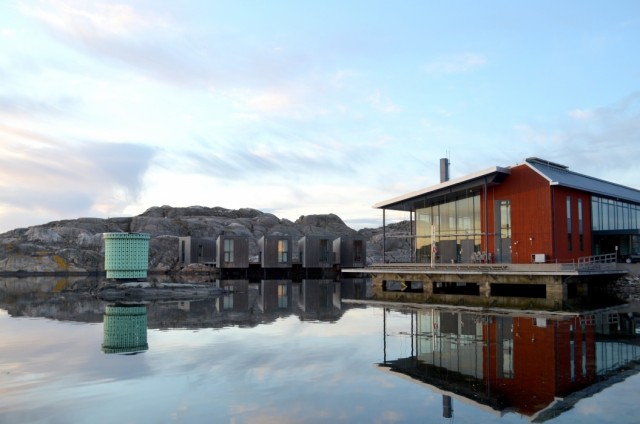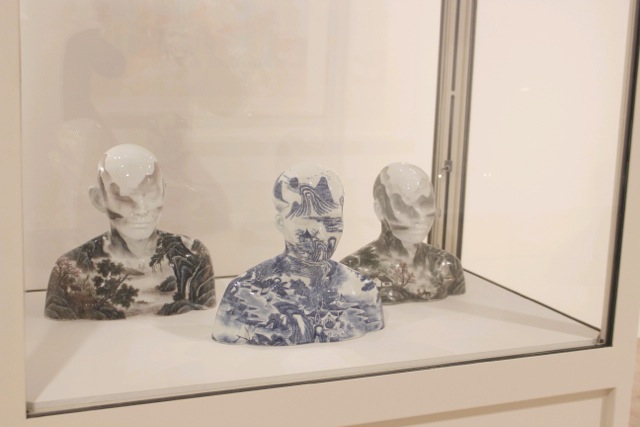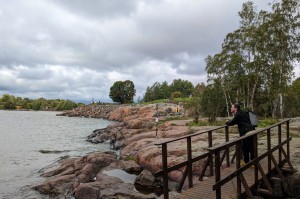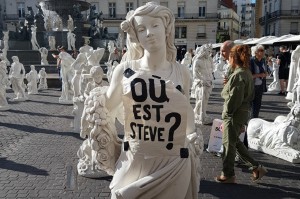Field Trip: Nordiska Akvarellmuseet, Sweden
Joe Zhu acts as art assistant to performative calligrapher Wang Dongling in the stunning setting of the Nordic Watercolour Museum; taking the opportunity to consider the traditions of Chinese calligraphy and how it is being translated into the contemporary…
It is a privilege being an art journalist; you have the perfect job to meet some of the most creative people on earth. In my case, it is even better: for the past several years, I started working with them part-time as an assistant and translator. I see this as a complement to my ‘day job’ for a newspaper in China, as an interview does not guarantee a good story, and even the good ones will miss out something that could be essential to an artist’s work.
For the past month, I’ve been in the Nordic countries, as an assistant to Wang Dongling, one of the leading figures of contemporary Chinese calligraphy. He was invited to perform at the opening of the group exhibition he was in, called China’s Changing Landscape, in the stunning Nordiska Akvarellmuseet (Nordic Watercolor Museum, below), located on Sweden’s West Coast, about one hour’s drive from Gothenburg. You can swim, listen to lectures, paint in the studios, or — as I did — visit the exhibitions.
Wang Dongling is a very interesting figure. He started as a traditional calligrapher and was among the first five Master students at the China Academy of Art (CAA) — the first year the school started a postgrad course. And later, he was influenced by his oversea students when he taught at CAA, and turned to more contemporary approaches. He started to write on almost everything he could get hold of: photographs, envelopes, wood, glass, until his pieces became larger. In the late 1980s/early ’90s, he began to concentrate on monumental sized works, turning his writing into a kind of performance. This is quite unusual amongst traditional calligraphers, who would see anything outside the proper calligraphy paper as ‘graffiti’; even the literati who show off their calligraphy skills during gatherings, performing in front of a public crowd, are seen as making a street show instead of a serious art performance.
Same as in the rest of the art world, people have differing perceptions of art in different ages. Wang Dongling is ahead of the game; even though he is in his 70s, his works are more vibrant than his acquaintances, and he is inevitably included in almost every contemporary art exhibition that has anything to do with Chinese ink art. This leads to China’s Changing Landscape.
One would think: how is calligraphy related to landscape painting? In fact, in traditional Chinese art, calligraphy has everything to do everything. First of all, we use the same brush to write with as well as to paint. Then, the painting technique evolves from writing. In most of the scrolls, when artists sign their names and dates, the words actually translate as ‘write’ (写) instead of ‘paint’ (画) . Another thing: although Wang is renowned for his huge calligraphy work and public performances, his recent work appears not unlike an expressive form of abstract landscape painting.

Wang has known the director of Nordiska Akvarellmuseet, Bera Nordal, for more than two decades, and met when he performed in one of her early exhibitions. So when the idea for China’s Changing Landscape formed, Wang’s name instantly became relevant. Not only was he asked to present a piece for exhibition, but also invited to perform as an essential part of the opening. Here is where my part came in: he needed a translator who can carry his big brush, and I’ve worked with him before at a Hong Kong exhibition two years ago.
By title, most would expect to see landscape paintings on canvas or paper gathering, but not here. Amongst the dozen artists included in the exhibition, international star Cai Guoqiang’s gun powder painting White Peony is about flowers; Ah Xi´an’s work is porcelain based (below); Yuan Jai’s painting is what we usually call flower and bird painting; Li Jin’s work as ever evolves from the self portrait; Samson Young’s installation is a document of a sound piece. And there is Wang Dongling, whose work is a painting using the oracle Chinese character 水 (water) as motif. The only thing that barely qualifies as landscape is a glance of garden appearing in one corner of one painting.

It will easily cause controversy amongst Chinese artists, because half the show does not fit the title. People could argue about which artists or works are more relevant to this show, as in the recent Ink Art exhibition at the Metropolitan Museum of Art, New York. But if you forget the landscape title and look at the exhibition without prejudice, it is quite rich in content and has lots to offer.
There are paintings of course, like Qui Zhijie’s bird-view series; a new approach of landscape painting which sees the world from above. Chinese landscape painting is always flat and without perspective of depth, it is very hard for westerners to grasp. But not Qiu’s; everyone uses digital maps today, and it is not hard to understand what he is trying to say. But it is not as simple as drawing a map. With several interviews over different periods, I know he has spent almost six years studying the traditional masters’ work to understand how they would make such a drawing. Together with Yang Yongliang’s digital landscape — digital content in a traditional disguise — Ah Xi´an’s porcelain painting, and Xu Bing’s digital video, this is true contemporary art.
What has made the exhibition different from Ink Art is that China’s Changing Landscape emphasises the aesthetic of art other than political ideas. This does not mean there is no political content, but that political themes feature more in the background context of the work. This is quite excellent for me; as a journalist who travels quite often overseas, I always see two extreme impressions of Chinese art: on one end is the museum antique scrolls, on the other is the political avant-garde from the late ’80s. As I travel, I am always asked about the current state of my homeland. The most frequent question is: is it as bad as we’ve heard? China is such a huge country, beside becoming one of the largest economies, there are other things going on: bad things do happen, as do good ones. In the case of art, the issues are adjacent to the two mentioned above.
Back to the exhibition. In a traditional sense, Chinese painters never paint what they actually see in nature, but what they believe they see. Landscape paintings hold a special place because of this, for it represents the artist’s world outlook, from the ancient scroll of the hideaway in the mountain, to the avant-garde ink paintings shown in Ink Art. They are not about the view the artists see, but in the way that they see it. In this sense, China’s Changing Landscape represents an artist’s world outlook of today, and the title makes perfect sense. The artists themselves have become the landscape, their works being the document. What better title can fit under this context?
Being involved in the exhibition, one of the best parts is not actually enjoying the free journey to the beautiful (and expensive) Nordic country (although that was wonderful), but trying to bring a better understanding of our culture to people who have limited opportunities to travel to China. The translation of the title is an essential part. In the gallery, I have to translate the English version to Wang Dongling first, then we find a Chinese equivalent, and then translate back to Chinese, which ends up being the piece that Dongling writes at the performance opening.
As co-curator Mark Johnson put it: ”Wong Dongling gave the exhibition its Chinese title – four characters from the I Ching, a 5,000-year old divination text known as the Book of Changes. The characters are translated to mean: The ultimate pursuit of knowledge is to understand change in the universe.”
Joe Zhu
Visit the Nordiska Akvarellmuseet: Södra hamnen 6, 471 32 Skärhamn, Sweden. Tel. +46 304-60 00 80
Open Tuesday – Sunday 12-5 pm; open studios on Saturday and Sunday 12-5 pm; admission fees adults, October-April: 50 SEK / adults, May – September: 80 SEK / under 25 years: admission free
China’s Changing Landscape continues at Nordiska Akvarellmuseet until 25 January 2015





